12.06.2025
My First Whisky: A Beginner's Guide to the World of Whisky
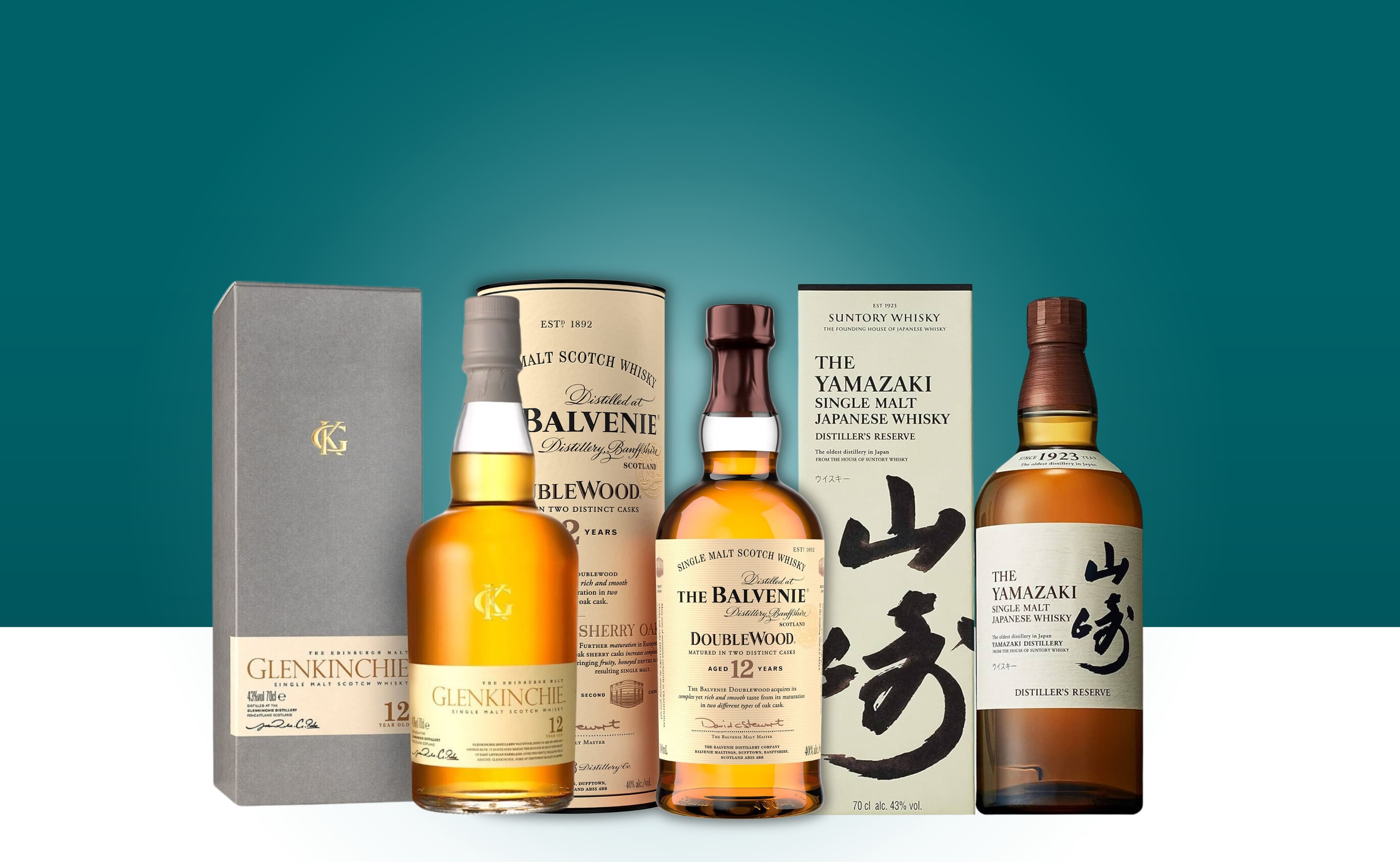
My First Whisky: A Beginner's Guide to the World of Whisky
So, you're interested in whisky? You're not the only one! Whisky has fascinated people all over the world, especially younger fans. Did you know:
-
39% of whisky drinkers are between 21 and 35 years old?
-
Flavored whiskies became 11% more popular in five years!
Your adventure starts now. Let's learn about this classic drink together. Here is your guide for beginners:
Key Takeaways
-
Whisky is made using grains like barley, corn, and rye. Each grain gives its own flavor, making whisky fun to explore.
-
For your first whisky, try blended or Irish whiskies. They are smoother and simpler for beginners to like.
-
To taste whisky, look at it, smell it, sip it, and notice the aftertaste. Take your time to enjoy the smells and flavors.
What Is Whisky?

Whisky is not just a drink; it’s history in a glass. But what is whisky? Let’s simplify it.

Origins and Global Appeal
Whisky has been around for centuries. It began in Scotland and Ireland, where monks tried distilling. Over time, it became a symbol of skill and tradition.
Here’s a quick look at whisky’s history highlights:
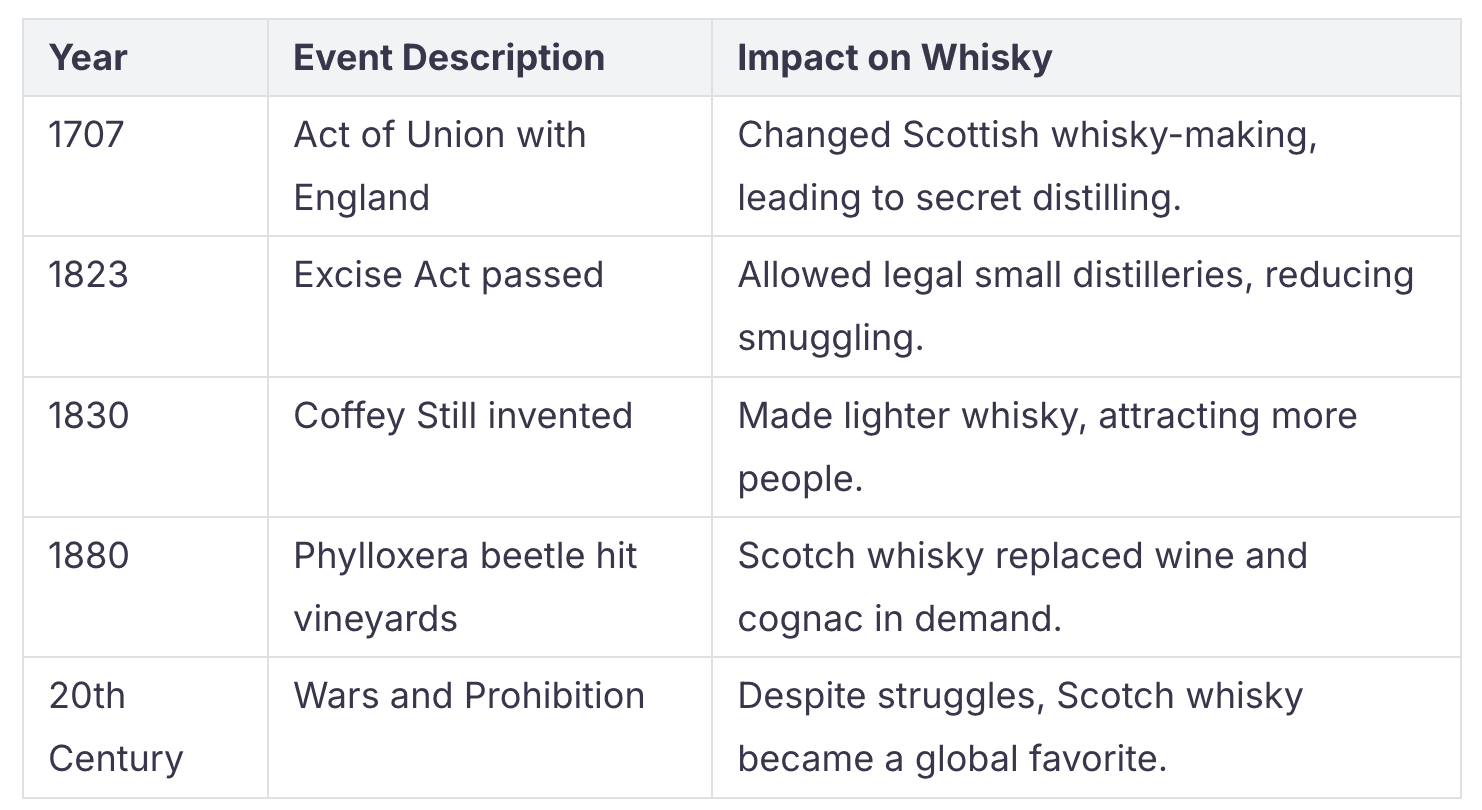
Today, whisky is made all over the world. Countries like India, Taiwan, and Australia are joining in. Ireland and Canadian whisky are also making a comeback. Small craft distilleries are growing too, offering new flavors and eco-friendly methods.
Key Characteristics of Whisky
What makes whisky unique? It’s the grains, the process, and the aging.
-
Grains: Barley gives a roasted taste. Corn adds sweetness. Rye adds spice, and wheat is softer.
-
Aging: Whisky ages in barrels, gaining flavors like vanilla and oak. Smaller barrels work faster but lose more liquid.
-
Flavors: Oak gives the “oaky” taste. Vanilla comes from vanillin. Fruity and spicy notes come from aging.
Every sip of whisky shares its journey from grain to glass.
How to Choose Your First Whisky
Picking your first whisky might seem tricky, but it’s not hard. With so many choices, learning the basics can help. Let’s take it step by step.
Understanding Different Types of Whisky
There are many kinds of whisky, each with its own taste. Knowing the differences can help you pick one you’ll like. Here’s a simple guide:
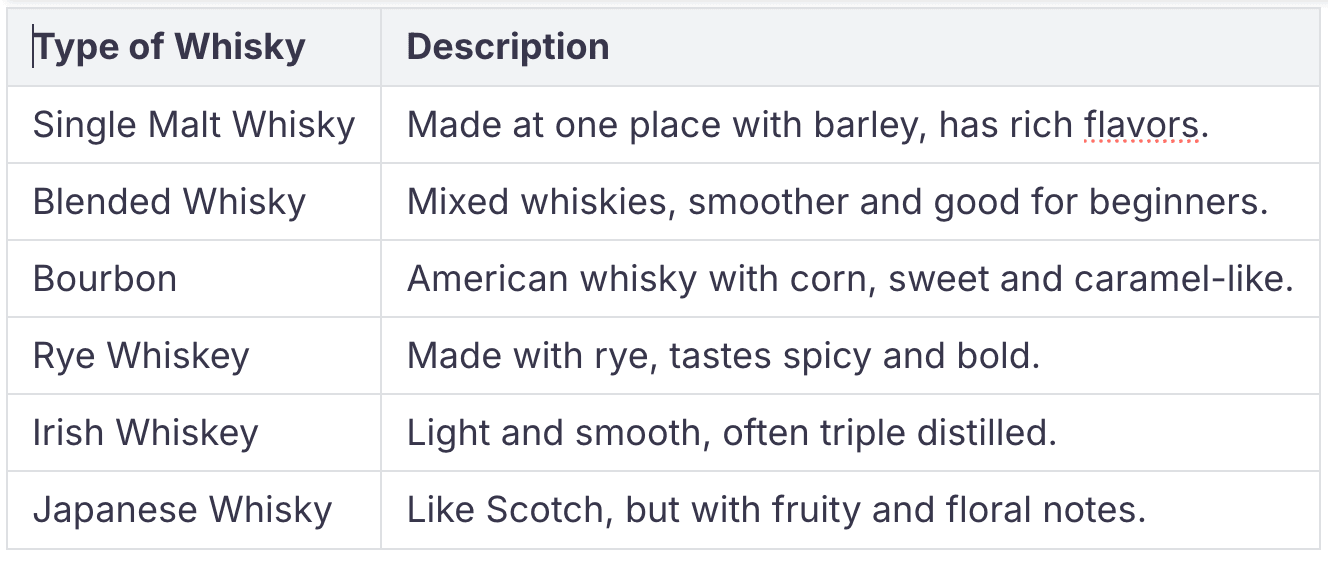
If you’re just starting, try blended or Irish whiskies. They’re smoother and easier to drink. Single malts are more complex and great for exploring later.
Beginner-Friendly Recommendations
Not sure what to try first? Here are some beginner-friendly whiskies people often suggest:
-
Speyside Whiskies: These are fruity and rich. Balvenie 12 Doublewood is a good choice and perfect for whisky beginners.
-
Lowlands Whiskies: Light and gentle, perfect for beginners. Try Glenkinchie 12 Years Old - a well balanced single malt scotch.
-
Blended Scotch: Smooth and versatile. Johnnie Walker Green Label or Dewar’s White Label are great.
-
American Bourbon: Sweet and easy to enjoy. Maker’s Mark or Buffalo Trace are popular.
-
Irish Whiskies: Mild and smooth flavor profile. Jameson Triple Triple is a classic favorite.
-
Japanese Whiskies: Floral and refined. Japan is making the best whiskies. Yamazaki Distillers Reserve is worth trying.
Tip: Not ready to buy a big bottle? Start with small sample packs. They’re affordable and let you try different kinds.
There’s no wrong choice with whisky. It’s all about what you like. Take your time, find your flavour profiles, try different ones, and ask for advice at stores or bars.
How to Taste Whisky
Tasting whisky is more than just sipping—it’s about engaging your senses and discovering the story behind each glass. Whether you’re a complete beginner or just curious, this step-by-step guide will help you savor every drop like a pro.
Step-by-Step Tasting Guide
Follow these steps to unlock the full experience of whisky tasting:
-
Visual Assessment
Hold your glass up to the light and take a moment to observe the color. Is it golden, amber, or deep mahogany? The color can hint at the type of barrel used for aging. Swirl the whisky gently and watch the "legs" (the streaks that run down the glass). Thicker legs often indicate higher alcohol content or viscosity. -
Nosing
Bring the glass to your nose and take a gentle sniff. Don’t rush—your nose is your best tool for detecting flavors. Swirl the whisky again to release more aromas, and try sniffing with your mouth slightly open. You might notice hints of vanilla, honey, or even smoky notes. Take your time to identify as many scents as you can. -
Tasting
Take a small sip and let it coat your tongue. Pay attention to the texture (is it smooth or oily?) and the flavors that emerge. Use a flavor wheel to help pinpoint specific tastes like fruity, spicy, or nutty. Don’t swallow right away—let the whisky linger in your mouth for a moment. -
The Finish
After swallowing, notice how the flavors evolve. Does the taste linger, or does it fade quickly? This is called the "finish." A long, complex finish often indicates a well-aged whisky. Reflect on your overall impression—did you enjoy it? What stood out to you?
Pro Tip: Start with a neat pour (no water or ice) to experience the whisky in its purest form. Then, add a few drops of water to see how the flavors change.
Tips for Enhancing the Experience
To make your whisky tasting even more enjoyable, keep these tips in mind:
-
Choose the Right Glassware
A tulip-shaped glass, like a Glencairn glass, is ideal. Its narrow opening concentrates the aromas, making it easier to detect subtle notes. -
Set the Scene
Find a quiet, well-lit space free from strong smells or distractions. A neutral environment helps you focus on the whisky’s characteristics. -
Cleanse Your Palate
Before tasting, drink some water or eat a plain cracker to reset your taste buds. This ensures you’re not influenced by lingering flavors from food or drinks. -
Experiment with Water
Adding a few drops of water can open up hidden aromas and soften the alcohol’s intensity. Use a clean dropper or spoon to control the amount. -
Take Notes
Keep a notebook handy to jot down your observations. Write about the color, aroma, taste, and finish. Over time, you’ll start noticing patterns in what you enjoy. -
Compare Whiskies
If you have more than one whisky, try tasting them side by side. This helps you identify differences in flavor profiles and find your preferences.
Did You Know? Humans have more flavor receptors in their nose than on their tongue. That’s why nosing is such an important part of whisky tasting!
By following these steps and tips, you’ll not only enjoy your whisky more but also develop a deeper appreciation for the craftsmanship behind it. Remember, there’s no right or wrong way to taste whisky—it’s all about discovering what you love.
Beginner-Friendly Whisky Cocktails
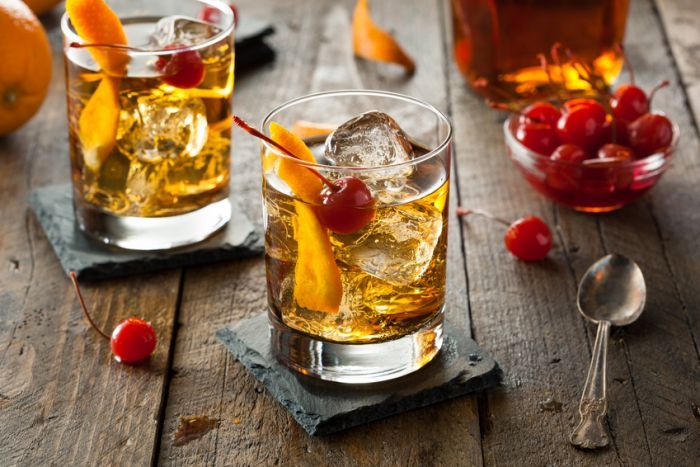
Whisky cocktails are a great way to start enjoying whisky. They mix the strong taste of whisky with other flavors, making drinks easier to enjoy. Let’s look at some simple cocktails and why they’re perfect for beginners.
Easy Cocktails to Try
Here are a few easy-to-make whisky cocktails. These drinks show how flexible whisky can be while keeping things simple:
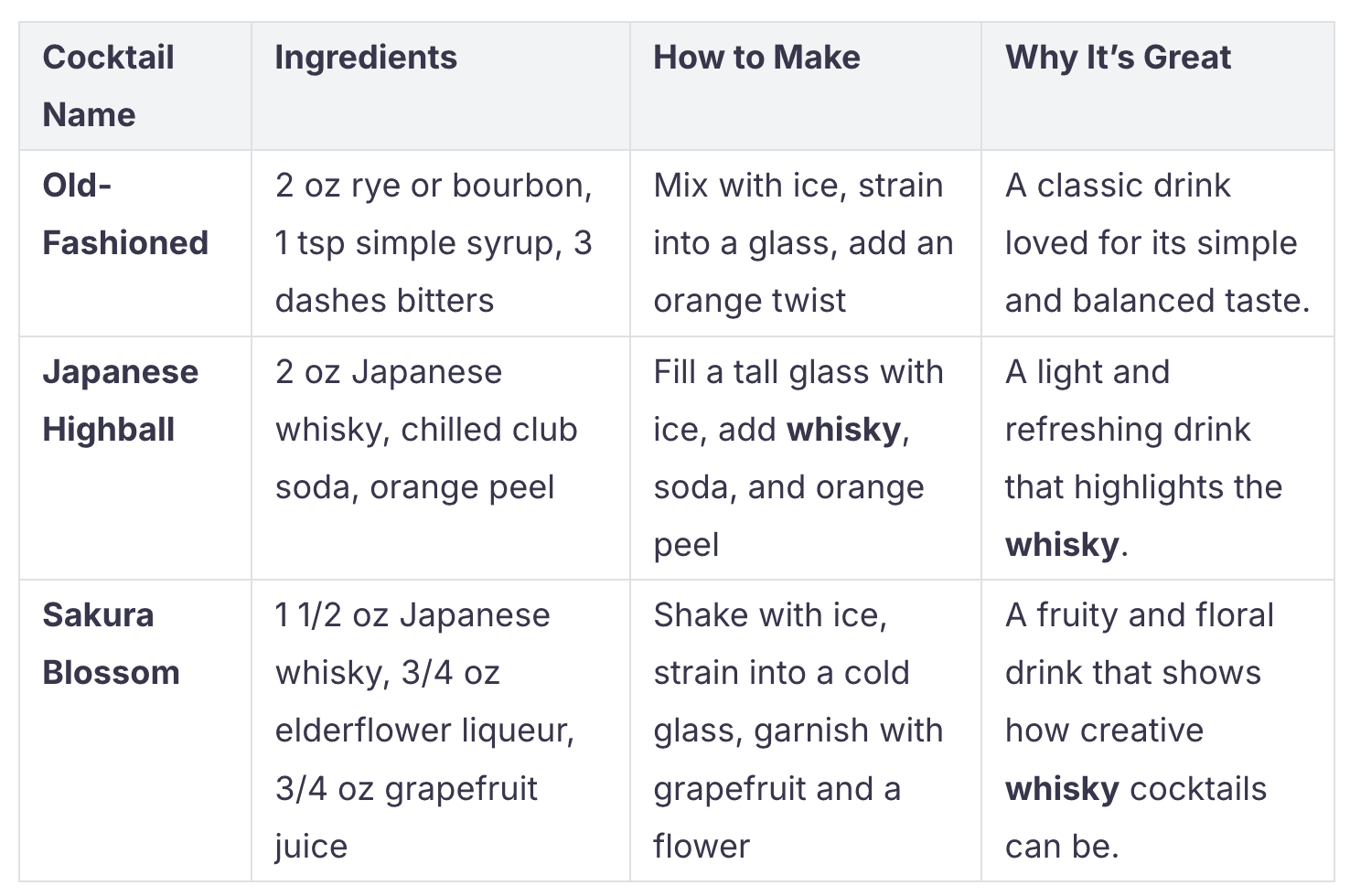
Tip: If you’re new to cocktails, try the Japanese Highball first. It’s simple, refreshing, and lets you enjoy the whisky without it being too strong.
Why Cocktails Are a Great Starting Point
Cocktails are a fun way to begin exploring whisky. They make the strong taste of whisky softer and easier to enjoy. By mixing whisky with other ingredients, you can try its flavors without feeling overwhelmed.
Another reason cocktails are great is their flexibility. You can change the sweetness, strength, or garnish to match your taste. For example, if you like fruity drinks, the Sakura Blossom is a good pick. If you prefer something classic, the Old-Fashioned is always a winner.
Fun Fact: In Japan, the Japanese Highball is so popular it’s served with meals, just like wine or beer in other countries.
Cocktails also make drinking whisky more social. They’re great for sharing with friends or enjoying at parties. Plus, they let you try different kinds of whisky in a fun way. So grab some ingredients and start mixing—you might find a new favorite drink!
Enjoying whisky is a personal experience. There’s no wrong way to like it—just explore and taste.
-
More people want better drinks, so whisky is growing.
-
Events like tastings and festivals teach you and connect you.
-
Social media makes learning about whisky easy and fun.
Go slow, try new things, and enjoy the journey. You’ll find your favorites!
FAQ
What’s the difference between whisky and whiskey?
The spelling depends on the country. Whisky is used in Scotland, Canada, and Japan. Whiskey is common in Ireland and the United States.
Should I drink whisky neat or with water?
It’s up to you! Start neat to taste the original flavors. Add a few drops of water to soften the alcohol and reveal hidden notes.
How should I store my whisky?
Keep it upright in a cool, dark place. Avoid direct sunlight and extreme temperatures. Once opened, seal it tightly to preserve the flavors.
Tip: Whisky doesn’t spoil like wine, but its taste can change over time if not stored properly.
About the author

Natalia Alejandrez Muñiz
I'm a whisky enthusiast and a writer in the making. I enjoy exploring new flavors, learning about the history behind each bottle, and sharing what I discover along the way. This blog is my space to grow, connect, and raise a glass with others who love whisky as much as I do.
To the author